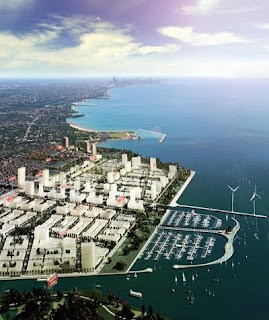South Works Proposal to Benefit Boating Community
A rendering of the proposed South Works project, which would eventually have 13,575 residential units, 17.5 million square feet of commercial space and a 1,500-slip marina.
South Works developers seek $98-million TIF subsidy
May 11, 2010
By Alby Gallun
From Chicago Real Estate Daily.com
A rendering of the proposed South Works project, which would eventually have 13,575 residential units, 17.5 million square feet of commercial space and a 1,500-slip marina.
(Crain’s) — The joint venture that wants to redevelop the massive South Works property on the south lakefront has asked the city for as much as $98 million in tax-increment financing to help pay for the project’s first phase, which would include a major shopping center and nearly 1,000 homes.
If the city signs off on the request, it would be the largest TIF grant ever for a private real estate development in Chicago. The Community Development Commission will consider the proposal at a 1 p.m. meeting Tuesday.
The commission’s blessing would mark a major step forward for Chicago-based developer McCaffery Interests Inc., which has been planning a development on the vacant steel mill site for more than five years. The TIF grant would help fund the project’s initial phase on the northwest corner of the 530-acre lakefront site, which sits between 79th Street and the Calumet River.
McCaffery, which is developing the site in a joint venture with property owner U.S. Steel Corp., plans to spend about $300 million on the 76-acre first phase, which would comprise 984 residential units and as much as a million square feet of retail and other commercial space.
“It’s really going to be a new downtown for the South Side of Chicago,” says McCaffery Partner Edmund Woodbury.
TIF grants are a controversial development tool because they direct property tax dollars that would normally fund school districts and other public services to pay for private- and public-sector building projects. Critics charge that the city abuses the TIF system by using it to subsidize developments that would go forward anyway.
That’s not the case with South Works, which has no sewers, streets or other infrastructure to support a real estate development, Mr. Woodbury says. The TIF would cover those public costs, he says.
“All that we’re asking for is what it takes to make the site buildable,” he says. “If any place needs it, this is the place. What’s the role of public investment? It’s infrastructure.”
The TIF money would cover nearly a third of the project’s costs, a high percentage for a private development, says lawyer and TIF consultant Samuel Polsky, a principal at Chicago-based Polsky & Associates Ltd.
“But it could be justified if it’s being used for streets, sewers and infrastructure,” he says.
The City Council also would have to sign off on the TIF request. Mr. Woodbury expects construction to begin in 2013 and the first stores to open in 2014.
Overall, McCaffery and U.S. Steel plan to build 13,575 residential units, 17.5 million square feet of commercial space and a 1,500-slip marina at South Works, a process that could take as many as 45 years to complete and cost more than $4 billion.
McCaffery’s more immediate priority is to find retail tenants for the shopping center, a tough task in the current economy. The firm will be pushing the project “really hard” to retailers at the International Council of Shopping Centers trade show this month in Las Vegas, Mr. Woodbury says.
The reception has been “quite positive” so far, he says, but retailers need to be educated about the neighborhood because they haven’t thought much about expanding there.
“The city’s been so north-centric that it’s exciting to open everyone’s eyes to the South Side of Chicago,” he says.
To read the original article
For More Information Ask Karma Yacht Sales by email or call 1-877-KARMA-Y-S (527-6297)


